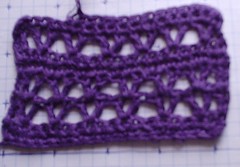So I have decided to copy Linda's great example and do the same thing for crocheted swatches. I just joined the Elann Samples Club for June 2009 and this is my first post reporting my experiences with the yarns. Please bear with me while I get used to doing this. I have quite shamelessly copied Linda's format, with only an odd change here & there.
First item up for improvement is my photography skills. I have a really crummy old digital camera and I'm not a very good photographer. My husband has a much nicer expensive camera and for the next test, I'll see if I can borrow it.
Also a general note here - it's hard to do a generic crochet swatch as you can alter the character of the fabric so dramatically by using different stitches or different hook sizes. The crocheted equivalent to a stockinette swatch would be plain sc, but there are very, very few garments made out of all sc. And the same yarn might work up very differently in a sc-based pattern vs. a dc-based pattern or one with a variety of stitches. The size of the sample skeins doesn't let you try out a whole bunch of different stitches. So I'll be picking stitch patterns to swatch based on what I think would work up well in that yarn. You need to take that into account when reading these reports.
So, here goes nothing ...
June 2, 2009
Elann Limited Edition Linen Twist
86% linen / 14% cotton
Made in Italy - Hand Wash / Dry Flat
Sport Weight
Knitting gauge 24 sts/4 inches, 2.5 - 3.0 mm (US 1-2)
50 g / 1.75 oz, 140 m / 152 yards
Color: Amethyst
Initial reactions
The yarn feels very string-like and crisp with very little give. The color is deep and very pretty; mine is “Amethyst” and much deeper than appears in the photograph that came with the samples. My sample is very evenly dyed with no under-dyed spots. When I rolled it into a little ball to start it snarled into a massive tangle that was very hard to un-tangle – I’ve had that experience with string-like yarns before however.
Swatch test
Hook: Size C bamboo (note that I crochet rather loosely)
Base chain of 20 stitches. For this swatch I did a combination of sc-rows and v-stitch rows.
Despite the string-like feel to the yarn, it does not feel hard on the hands to work with. The main negative in working with this yarn is that it is extremely splitty. As I worked I’d realize that there was a loop floating out there all on its own because the yarn had split and I hadn’t noticed. While I went back and got most of them, you can probably see in the photo that I didn't catch them all. Pulling the work back wasn’t fun as the yarn separated even more, and it was very hard to pull a loop back out to start working. I think a metal hook would have been a better choice than the bamboo one that I used.
Preblock

Width gauge - 20 sts = 4"
My swatch consisted of 5 rows of sc all told, and 3 rows of dc v-stitches, and was just over 2"
I pinned the pre-block swatch down as it curled like crazy.
The finished swatch is very stretchy, much stretchier than I would have anticipated given the stiff feel of the yarn. But it's a sturdy kind of stretchy. The fabric feels flexible & strong – I think it would make a really good market bag.
Soak
I soaked the swatch in water and a drop or two of dishwashing liquid to remove any spinning oil. I soaked it long enough for a pot of coffee to brew, 5 or 10 minutes, and swished it around a few times during that time. There was some dye run - not a lot, but I didn't need to squint to see it. I squeezed as much water out as I could and then rolled up in a clean towel and squeezed some more.
Post-block

The yarn has softened up a lot, and the stitches have opened up considerably. The swatch now lies perfectly flat with no tendency to curl at all. The fabric is much, much drapier post-wash and I think it would make a nice sweater or shawl. It is very lovely in fact. It is not quite as stretchy as pre-blockt, though it still has a fair amount of diagonal give. I still think it would make a nice market bag.
The width of the swatch is exactly the same size as pre-block, however it's grown in height.
Abuse test
I'll be doing abuse tests whenever I think a yarn might stand it well. When we get into the winter yarns, I'll probably call this a "felting test" but for now it's just a wash & dry test. I'm not advocating abusing your yarns, but sometimes you learn a lot by giving a swatch a good beating. Some yarns actually get even better after a macnine wash & dry, particularly some plant fiber yarns.
For this yarn I put it into a load with some light-colored things on Warm and dried on regular. I would have put it in with the darks except for poor planning on my part - I've already done dark laundry for the week and wanted to get this report out on time! Next time I'll try to plan better.
The swatch picture looks awful so I won't post, but basically it shrunk to 3.5" sideways and 2" height. But the stretchiness is back and I'm pretty sure I could iron it back into the original post-block size. It's very soft and almost cuddly now. I'm thinking that depending on what you make out of it, this yarn can take this kind of treatment. All usual disclaimers apply.